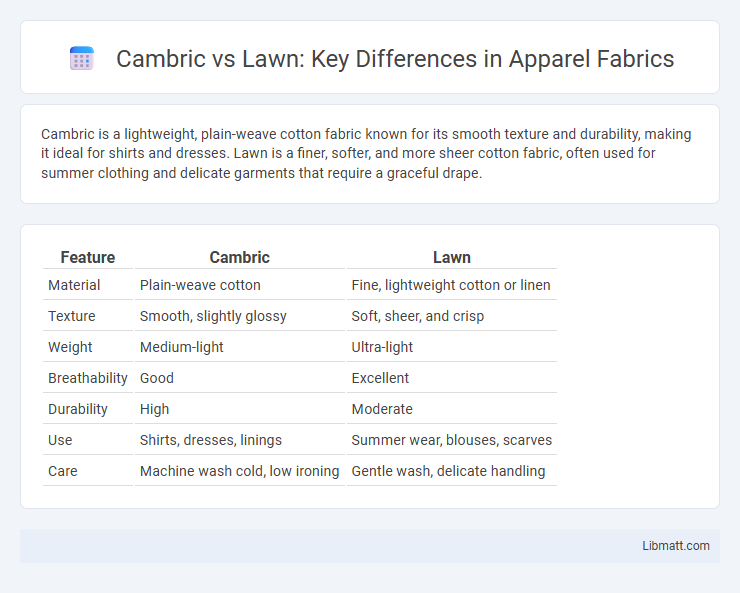Cambric is a lightweight, plain-weave cotton fabric known for its smooth texture and durability, making it ideal for shirts and dresses. Lawn is a finer, softer, and more sheer cotton fabric, often used for summer clothing and delicate garments that require a graceful drape.
Table of Comparison
| Feature | Cambric | Lawn |
|---|---|---|
| Material | Plain-weave cotton | Fine, lightweight cotton or linen |
| Texture | Smooth, slightly glossy | Soft, sheer, and crisp |
| Weight | Medium-light | Ultra-light |
| Breathability | Good | Excellent |
| Durability | High | Moderate |
| Use | Shirts, dresses, linings | Summer wear, blouses, scarves |
| Care | Machine wash cold, low ironing | Gentle wash, delicate handling |
Introduction to Cambric and Lawn
Cambric is a lightweight, plain-weave fabric made from fine cotton or linen, known for its smooth texture and durability, often used in garments like shirts and handkerchiefs. Lawn is a sheer, finely woven cotton fabric with a crisp feel and slight sheen, favored for summer dresses and blouses due to its breathable, lightweight nature. Both fabrics offer excellent softness and breathability, but cambric is generally more opaque and sturdy, while lawn provides a delicate, semi-transparent finish.
Historical Origins of Cambric and Lawn Fabrics
Cambric fabric originated in the town of Cambrai, France, during the Middle Ages, valued for its fine, lightweight, and smooth texture ideal for shirts and handkerchiefs. Lawn fabric traces its roots to the city of Lahore (historically known as "Lahori"), blending cotton and linen to create a soft, sheer material popular in South Asia for summer garments. Both fabrics have evolved through centuries, maintaining their reputation for breathability and delicate appearance in textile history.
Fiber Composition: What Are They Made Of?
Cambric and lawn fabrics are both lightweight textiles primarily made from 100% cotton fibers, ensuring breathability and comfort. Cambric features a fine, closely woven construction that provides a smooth texture, while lawn is woven with finer yarns, resulting in an even softer and more sheer fabric. Both materials can occasionally include blends with synthetic fibers for added durability, but pure cotton remains the most common fiber composition in both fabrics.
Weaving Techniques: Cambric vs Lawn
Cambric fabric is woven using a fine, plain weave that creates a smooth, lightweight texture ideal for shirts and handkerchiefs. Lawn fabric also employs a plain weave but utilizes finer, high-twist cotton yarns, resulting in a softer, semi-sheer finish with greater drape. The difference in yarn twist and thread density distinguishes cambric's crispness from lawn's delicate, airy quality.
Texture and Feel Comparison
Cambric offers a lightweight, crisp texture with a smooth finish, making it ideal for breathable summer garments. Lawn fabric feels softer and more silky, characterized by a finer, more delicate weave that enhances comfort against your skin. Choosing between these fabrics depends on whether you prioritize a firm structure or a gentle, airy feel.
Breathability and Comfort
Cambric offers moderate breathability with a smooth texture, making it comfortable for everyday wear, especially in mild climates. Lawn fabric is highly breathable due to its lightweight and finely woven cotton fibers, providing superior comfort in hot and humid conditions. Both fabrics are soft, but lawn's enhanced airflow makes it a preferred choice for optimal cooling and moisture-wicking in warm weather.
Durability and Longevity
Cambric fabric is known for its superior durability due to its tightly woven cotton fibers, making it resistant to wear and tear over extended use. Lawn fabric, while soft and lightweight, tends to be more delicate and can show signs of wear faster under frequent washing and heavy use. Choosing cambric ensures longer-lasting clothing and textiles that maintain structural integrity through many washes.
Best Uses and Applications
Cambric fabric, known for its lightweight and smooth texture, is ideal for making summer clothing, handkerchiefs, and light curtains, offering breathability and a crisp finish. Lawn fabric, characterized by its finer weave and silky feel, is best suited for high-end apparel, such as dresses and blouses, as well as delicate linings that require a soft drape. Both fabrics excel in warm-weather garments, but cambric's slightly sturdier quality makes it better for items requiring more structure, while lawn's delicacy favors elegant, flowing designs.
Care and Maintenance Differences
Cambric fabric requires gentle washing with mild detergent and should be air-dried to maintain its smooth texture, whereas lawn fabric is more durable and can withstand machine washing on a gentle cycle without significant wear. Lawn fabric's higher thread count provides better resistance to shrinking and fading, making it easier to maintain over time. Understanding these care differences will help you extend the lifespan and appearance of your garments made from either fabric.
Choosing the Right Fabric: Cambric or Lawn?
Cambric offers a slightly heavier, more durable texture with a soft finish, making it ideal for crisp shirts and structured garments, while Lawn is a lightweight, finely woven cotton known for its smooth, breathable feel, perfect for delicate summer dresses and blouses. When selecting between Cambric and Lawn, consider the garment's purpose, desired drape, and climate suitability, as Cambric provides more resilience and Lawn delivers superior lightness and softness. Evaluating thread count, fiber quality, and intended wear ensures the right fabric choice tailored to comfort and style.
Cambric vs Lawn Infographic

 libmatt.com
libmatt.com